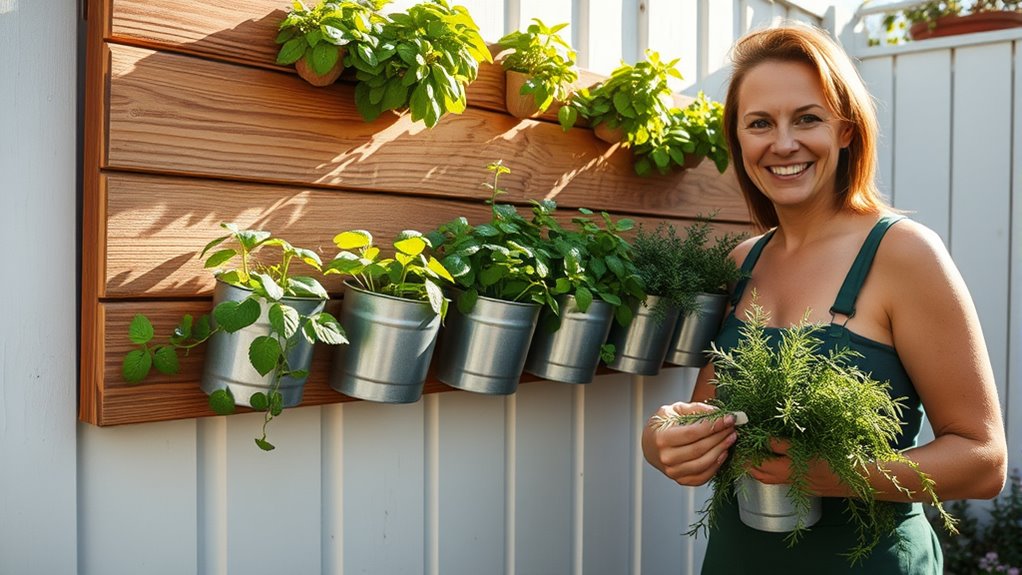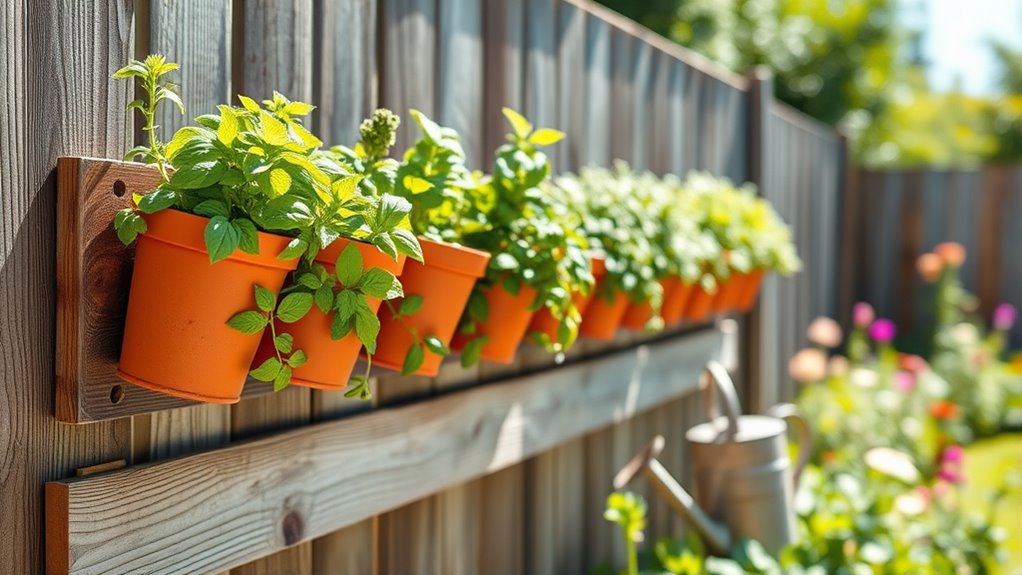To build a simple vertical herb garden this weekend, choose sturdy, well-draining containers like repurposed pallets or crates. Fill them with quality potting soil suitable for herbs and plant taller herbs such as basil and mint towards the back, with smaller ones like thyme and oregano at the front for easy harvesting. Water regularly, ensuring soil stays moist but not soggy, and keep pests under control with natural remedies. For more tips on setup and care, keep going!
Key Takeaways
- Choose a sturdy, well-draining container or wall-mounted frame suitable for vertical planting.
- Fill containers with quality potting soil tailored for herbs, ensuring drainage holes are present.
- Plant taller herbs like basil and mint at the back or center, and compact herbs at the front for easy access.
- Water thoroughly but sparingly, maintaining consistent moisture without overwatering to prevent pests.
- Place the garden in a well-lit area, monitor for pests, and regularly prune for healthy growth.

If you’ve ever wanted fresh herbs at your fingertips without taking up much space, building a simple vertical herb garden is a perfect weekend project. Not only does it make your kitchen or balcony more vibrant, but it also provides easy access to basil, thyme, mint, and other favorites. To get started, choose a sturdy frame or wall-mounted planter that fits your space. You can repurpose old pallets, wooden crates, or buy pre-made vertical planters. Once you’ve set up your structure, fill it with quality potting soil suitable for herbs. Make certain the containers have drainage holes to prevent water from pooling, which can lead to root rot.
Create a vibrant vertical herb garden with simple DIY planters and quality soil.
When planting your herbs, consider their growth habits. Place taller herbs like basil or mint toward the back or center, and keep compact ones like thyme or oregano at the front. This arrangement ensures easy harvesting and good air circulation. As you begin watering, keep in mind that vertical gardens can dry out more quickly than traditional beds. Water your herbs thoroughly but sparingly, ensuring the soil stays moist but not soggy. Use a watering can or a gentle sprayer to avoid disturbing the roots or washing away the soil. Regular watering is key, especially during hot weather, but avoid overwatering, which can cause pests and disease issues.
Speaking of pests, maintaining pest control is vital for a healthy herb garden. Keep an eye out for common pests such as aphids, spider mites, and whiteflies. If you spot tiny insects or sticky residue on your leaves, treat your plants with natural remedies like neem oil or insecticidal soap. Good airflow around your herbs helps prevent fungal issues and discourages pests, so don’t overcrowd your planters. Additionally, regularly inspect your plants and remove any damaged or diseased leaves promptly. Incorporating proper lighting can also enhance plant health and growth, especially for indoor vertical gardens.
A well-maintained vertical herb garden requires a little attention, but the rewards are worth it. Proper watering ensures your herbs stay lush and flavorful, while vigilant pest control keeps your plants healthy and productive. By choosing the right containers, arranging your herbs thoughtfully, and sticking to a consistent watering schedule, you’ll create a thriving mini garden that’s both functional and beautiful. Plus, the act of caring for your herbs can become a relaxing weekend ritual. With these simple steps, you’ll enjoy fresh herbs for months to come and impress friends with your gardening skills—all within the comfort of your own space.
Frequently Asked Questions
What Are the Best Herbs for Indoor Vertical Gardens?
For your indoor vertical garden, choose herbs like basil, mint, parsley, and chives—they thrive in small spaces. These herbs often benefit from companion planting, which boosts growth and flavor. To keep your garden thriving, focus on herb propagation techniques like cuttings and seed starting. Regularly harvest to encourage healthy growth, and guarantee your herbs get adequate light and airflow for the best results.
How Often Should I Water My Vertical Herb Garden?
Think of your vertical herb garden as a delicate dance; to keep it thriving, watering frequency is key. You should check soil moisture daily, ensuring it stays moist but not soggy. When the top inch of soil feels dry, it’s time to water. Overwatering drowns roots, while underwatering leaves herbs thirsty. Find that perfect rhythm, and your garden will flourish with vibrant, fragrant herbs.
Can I Use Recycled Materials for the Garden Frame?
Yes, you can definitely use recycled materials for your garden frame, making it a more eco-friendly garden. Recycled wood, plastic bottles, or scrap metal work well and add a unique touch. Just make certain the materials are clean and safe for plants. Using recycled items not only reduces waste but also creates a sustainable, eco-conscious garden that benefits the environment while beautifying your space.
What Is the Ideal Sunlight Exposure for These Herbs?
You should consider the sunlight requirements and shade tolerance of your herbs when placing your garden. Most herbs thrive with at least 6 hours of direct sunlight daily, but some tolerate partial shade. For example, basil loves full sun, while mint prefers some shade. By understanding each herb’s shade tolerance, you can optimize their growth and health, ensuring your vertical garden flourishes.
How Do I Prevent Pests in a Vertical Herb Garden?
Did you know that pests can reduce herb yields by up to 50%? To prevent pests in your vertical herb garden, implement pest control strategies like introducing natural deterrents such as neem oil, garlic spray, and companion planting. Regularly inspect your herbs for early signs of pests, remove affected leaves, and keep your garden tidy. These steps will help protect your herbs naturally and ensure a healthy, thriving garden.
Conclusion
As you step back to admire your vertical herb garden, it’s funny how the simple act of building it coincided with a fresh burst of inspiration in your cooking. Sometimes, the smallest projects unexpectedly lead to the biggest joys—like discovering new flavors or finding calm in your daily routine. This little garden isn’t just about herbs; it’s a reminder that even in busy weekends, unexpected moments of growth and creativity can blossom right at home.









